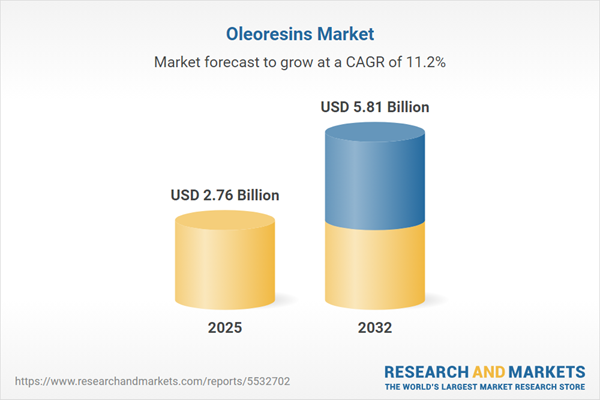Speak directly to the analyst to clarify any post sales queries you may have.
Senior decision-makers seeking to strengthen ingredient sourcing and product innovation are closely monitoring the evolving oleoresins market. With changing regulatory frameworks, production technologies, and supply chain models, understanding the strategic role of oleoresins is essential for organizations aiming for long-term resilience and competitiveness.
Market Snapshot: Oleoresins Market Size and Growth
The Oleoresins Market grew from USD 2.49 billion in 2024 to USD 2.76 billion in 2025. It is expected to continue growing at a CAGR of 11.17%, reaching USD 5.81 billion by 2032. Rising demand for clean label ingredients, application diversity across food, pharmaceutical, and cosmetic sectors, and a shift towards sustainable sourcing are core factors driving robust expansion. Companies are focusing on procurement agility and compliance modernization as trade policies and consumer preferences reshape the competitive landscape.
Scope & Segmentation
- Product Types: Includes Capsicum Oleoresin, Garlic Oleoresin, Ginger Oleoresin, Paprika Oleoresin, and Turmeric Oleoresin, each contributing unique sensory and functional qualities to applications.
- Applications: Spans Animal Feed, Cosmetics, Food and Beverages, and Pharmaceuticals, reflecting the compound’s versatility across industries.
- Forms: Offers both Liquid and Powder options, enabling precise dosing, formulation flexibility, and adaptation to diverse manufacturing environments.
- Extraction Methods: Covers Solvent Extraction and Supercritical CO2 Extraction, aligning with operational priorities such as purity profiles, yield optimization, and solvent residue management.
- Regional Coverage: Americas (including United States, Canada, Mexico, Brazil, Argentina, Chile, Colombia, Peru), Europe, Middle East & Africa (comprising United Kingdom, Germany, France, Russia, Italy, Spain, Netherlands, Sweden, Poland, Switzerland, United Arab Emirates, Saudi Arabia, Qatar, Turkey, Israel, South Africa, Nigeria, Egypt, Kenya), and Asia-Pacific (China, India, Japan, Australia, South Korea, Indonesia, Thailand, Malaysia, Singapore, Taiwan).
- Key Companies: Includes Synthite Industries Private Limited, Kalsec Inc, Döhler GmbH, Symrise AG, Givaudan S.A., Treatt plc, Davis Food Ingredients Inc, A. M. Todd Company, Indesso Aroma Private Limited, and Axxence Aromatic GmbH.
Key Takeaways for Decision-Makers
- Oleoresins enable consistent flavor, color, and performance, enhancing reproducibility and streamlining product development across multiple sectors.
- Shifts in consumer preference for natural and traceable ingredients raise the importance of provenance documentation and advanced process control.
- Adoption of green extraction and digital supply chain tools support sustainability targets, traceability, and regulatory compliance, which are now integral to supplier selection and brand positioning.
- Form selection (liquid or powder) influences downstream integration, storage, and delivery performance, providing versatility in production lines and finished goods.
- Regional strategies must adapt to differing regulatory demands, supply chain infrastructure, and the pace of demand growth, particularly in Asia-Pacific and EMEA markets.
Tariff Impact on Sourcing and Procurement
Recent United States tariff adjustments are reshaping procurement strategies and origin preferences for import-dependent companies. The resulting changes in cost structure, supplier selection, and contract terms prompt buyers to consider alternative sourcing regions and inventory models. Organizations are building more resilient supply chains through nearshoring, supply base diversification, and risk-sharing agreements to mitigate tariff volatility and ensure critical ingredient continuity.
Methodology & Data Sources
This report uses a robust mixed-methods approach, combining primary interviews with sourcing, procurement, and technical leaders, alongside secondary research into regulatory standards and extraction methods. Cross-validation with analytical performance benchmarks and third-party certifications ensures factual accuracy and industry relevance.
Why This Report Matters
- Delivers actionable insights for procurement, R&D, and compliance leaders seeking to strengthen supply resilience and product differentiation with oleoresins.
- Supports investment and partnership decisions by outlining key market trends, regulatory developments, and best practices in sustainable sourcing and extraction technology.
- Enables strategic alignment across global operations by analyzing regional dynamics, supply chain risks, and market entry considerations.
Conclusion
The strategic value of oleoresins will continue increasing as companies pursue clean label innovation, regulatory compliance, and flexible sourcing models. Ongoing investment in technology, traceability, and supplier collaboration remains central to capturing long-term market advantage with oleoresins.
Additional Product Information:
- Purchase of this report includes 1 year online access with quarterly updates.
- This report can be updated on request. Please contact our Customer Experience team using the Ask a Question widget on our website.
Table of Contents
3. Executive Summary
4. Market Overview
7. Cumulative Impact of Artificial Intelligence 2025
List of Figures
Samples

LOADING...
Companies Mentioned
The key companies profiled in this Oleoresins market report include:- Synthite Industries Private Limited
- Kalsec Inc
- Döhler GmbH
- Symrise AG
- Givaudan S.A.
- Treatt plc
- Davis Food Ingredients Inc
- A. M. Todd Company
- Indesso Aroma Private Limited
- Axxence Aromatic GmbH
Table Information
| Report Attribute | Details |
|---|---|
| No. of Pages | 180 |
| Published | October 2025 |
| Forecast Period | 2025 - 2032 |
| Estimated Market Value ( USD | $ 2.76 Billion |
| Forecasted Market Value ( USD | $ 5.81 Billion |
| Compound Annual Growth Rate | 11.1% |
| Regions Covered | Global |
| No. of Companies Mentioned | 11 |









